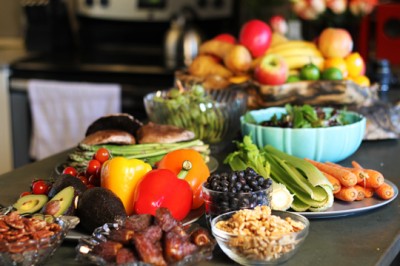Diet trends tend to come and go, but a recent one with staying power is the Paleo diet. With its promises of improving your metabolism, your heart health, your blood sugar and your weight, the Paleo diet focuses on foods our ancestors ate.
In this case, your ancestors are not your grandparents or even your great-grandparents, mind you, but your ancestors who lived thousands of years ago.
In other words, the Paleo diet embraces a hunter-gatherer lifestyle. Think fresh meat and fish as well as nuts, berries, seeds and leafy greens – not grains, pastas, sugars or processed foods
The advantages of the Paleo diet include:
- High protein from chicken, eggs, fish and lean meats.
- High fiber and rich vitamin and mineral content from fresh fruits and vegetables eaten in their raw forms.
- Healthy Omega-3 fatty acids from seafood, fish, nuts and seeds.
- Good-for-you oils from seeds and nuts.
- Less sugar, sodium, saturated fats and carbs than processed foods contain.
In addition, in his book Paleo for Beginners, author John Chatham says that we digest the protein and fiber from Paleo foods more slowly than other foods, keeping us fuller longer and helping us burn more fat.
Could This All-Natural ‘Detox’ Capsule Have Extended John Wayne’s Life?
According to a research study published in 2009 in the European Journal of Clinical Nutrition, participants experienced improved blood pressure levels, lower plasma insulin and significant reductions in “bad” LDL cholesterol, and triglycerides after only two weeks on a Paleo diet.
Critics of the diet say it does not work well for vegetarians, since it relies on meat and fish. Others say it is not practical in a world that increasingly relies on grains, legumes and dairy products for food.
Also, it is difficult to sustain a full Paleo diet today. The cost of eating only wild-caught fish and grass-fed beef, for example, is unrealistic for many family budgets.
However, it is possible to pursue a modified Paleo diet with a little time, planning and effort. Remember there is no one-size-fits-all Paleo diet, nor should there be. You may choose to include raw dairy products in a modified Paleo diet, for example.
What you are trying to do by eating “Paleo” is to focus on whole foods in their natural state and to limit your consumption of processed foods. Here is a basic “Eat this not that” list to help you get started.
Eat this:
- Grass-fed meats
- Wild-caught fish and seafood
- Fresh fruits and berries
- Fresh vegetables
- Eggs from free-range chickens
- Nuts
- Seeds
- Healthy oils, including olive, flaxseed, macadamia, coconut, walnut and avocado oils
Don’t eat this:
- Cereal grains
- Legumes (including peanuts)
- Processed dairy products
- Processed foods
- Refined sugar
- Starchy vegetables such as potatoes
- Refined vegetable oils
- Candy and junk food
According to Paleo nutrition experts, 60 percent of the energy we get from food should come from wild-caught fish, bison, deer, turkey and eggs. These foods are high in Omega-3 fatty acids and low in Omega-6 fatty acids. Omega-3-rich foods fats can help reduce inflammation in the body. They also can improve brain and neurological function, aid in digestion and restore healthy skin.
The Hidden Secrets Of Making Herbal Medicines…Right At Your Fingertips!
Paleo experts also recommend that 40 percent of our energy from food comes from raw fruits, vegetables, seeds and nuts. These foods are nutrient-dense.
An added benefit of a Paleo diet is that it is gluten-free. The fact that so many American have developed intolerance to gluten indicates our modern reliance on gluten-rich grains and cereals.
Here are other tips for making a modified Paleo diet part of your healthy lifestyle:
- Eat your fruits and veggies. The amount of fruits and vegetables you eat at each meal should be roughly twice the amount of meat, fish or eggs.
- Eat grains in moderation. You can have occasional small servings of lentils, quinoa, black beans, amaranth or buckwheat on a modified Paleo diet. While most Paleo experts advise you to avoid starchy white potatoes, they do allow beets, yams, sweet potatoes, Jerusalem artichokes and turnips on a limited basis.
- Limit your dairy. Strict Paleo diet folks will disagree, but many nutritionists feel that small amounts of raw and or fermented dairy products are linked with better bone health and even a healthy reproduction system. Raw and fermented dairy products also introduce beneficial bacteria to your body.
If you decide to consume dairy products, raise your own cows, sheep or goats for the purpose or choose products made from organic, pasture-raised, grass-fed, full fat and fermented yogurt, kefir and cheese.
Keep in mind that the word “Paleo” does not mean “healthy.” In fact, many so-called Paleo recipes on social media sites are high in fat and sugar. Even Paleo treats and desserts need to be eaten in moderation.
Also, a strict Paleo diet eliminates healthy and nutritious grains and legumes. The benefits of a Paleo diet, however, are its focus on whole foods and its elimination of process, packaged foods. Those are important goals that can benefit the health of your family.
What do you think? Share your thoughts in the section below:
Harness The Power Of Nature’s Most Remarkable Healer: Vinegar
 Off The Grid News Better Ideas For Off The Grid Living
Off The Grid News Better Ideas For Off The Grid Living





